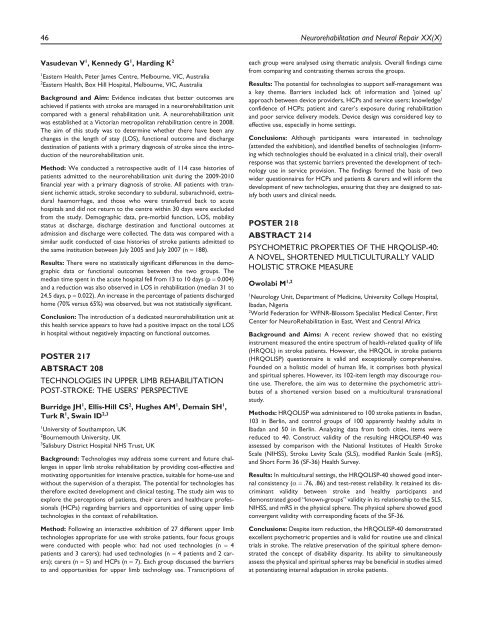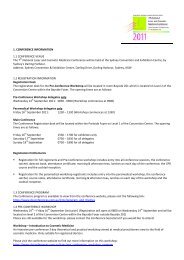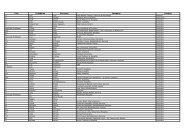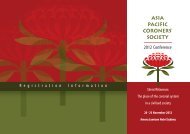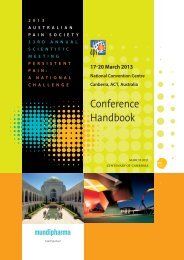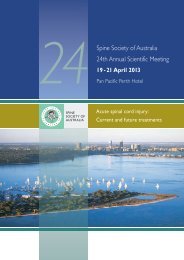WCNR 2012 Poster Abstracts - DC Conferences
WCNR 2012 Poster Abstracts - DC Conferences
WCNR 2012 Poster Abstracts - DC Conferences
Create successful ePaper yourself
Turn your PDF publications into a flip-book with our unique Google optimized e-Paper software.
46 Neurorehabilitation and Neural Repair XX(X)Vasudevan V 1 , Kennedy G 1 , Harding K 21 Eastern Health, Peter James Centre, Melbourne, VIC, Australia2 Eastern Health, Box Hill Hospital, Melbourne, VIC, AustraliaBackground and Aim: Evidence indicates that better outcomes areachieved if patients with stroke are managed in a neurorehabilitation unitcompared with a general rehabilitation unit. A neurorehabilitation unitwas established at a Victorian metropolitan rehabilitation centre in 2008.The aim of this study was to determine whether there have been anychanges in the length of stay (LOS), functional outcome and dischargedestination of patients with a primary diagnosis of stroke since the introductionof the neurorehabilitation unit.Method: We conducted a retrospective audit of 114 case histories ofpatients admitted to the neurorehabilitation unit during the 2009-2010financial year with a primary diagnosis of stroke. All patients with transientischemic attack, stroke secondary to subdural, subarachnoid, extraduralhaemorrhage, and those who were transferred back to acutehospitals and did not return to the centre within 30 days were excludedfrom the study. Demographic data, pre-morbid function, LOS, mobilitystatus at discharge, discharge destination and functional outcomes atadmission and discharge were collected. The data was compared with asimilar audit conducted of case histories of stroke patients admitted tothe same institution between July 2005 and July 2007 (n 188).Results: There were no statistically significant differences in the demographicdata or functional outcomes between the two groups. Themedian time spent in the acute hospital fell from 13 to 10 days (p 0.004)and a reduction was also observed in LOS in rehabilitation (median 31 to24.5 days, p 0.022). An increase in the percentage of patients dischargedhome (70% versus 65%) was observed, but was not statistically significant.Conclusion: The introduction of a dedicated neurorehabilitation unit atthis health service appears to have had a positive impact on the total LOSin hospital without negatively impacting on functional outcomes.POSTER 217ABTSRACT 208TECHNOLOGIES IN UPPER LIMB REHABILITATIONPOST-STROKE: THE USERS’ PERSPECTIVEBurridge JH 1 , Ellis-Hill CS 2 , Hughes AM 1 , Demain SH 1 ,Turk R 1 , Swain ID 2,31 University of Southampton, UK2 Bournemouth University, UK3 Salisbury District Hospital NHS Trust, UKBackground: Technologies may address some current and future challengesin upper limb stroke rehabilitation by providing cost-effective andmotivating opportunities for intensive practice, suitable for home-use andwithout the supervision of a therapist. The potential for technologies hastherefore excited development and clinical testing. The study aim was toexplore the perceptions of patients, their carers and healthcare professionals(HCPs) regarding barriers and opportunities of using upper limbtechnologies in the context of rehabilitation.Method: Following an interactive exhibition of 27 different upper limbtechnologies appropriate for use with stroke patients, four focus groupswere conducted with people who: had not used technologies (n 4patients and 3 carers); had used technologies (n 4 patients and 2 carers);carers (n 5) and HCPs (n 7). Each group discussed the barriersto and opportunities for upper limb technology use. Transcriptions ofeach group were analysed using thematic analysis. Overall findings camefrom comparing and contrasting themes across the groups.Results: The potential for technologies to support self-management wasa key theme. Barriers included lack of: information and ‘joined up’approach between device providers, HCPs and service users; knowledge/confidence of HCPs; patient and carer’s exposure during rehabilitationand poor service delivery models. Device design was considered key toeffective use, especially in home settings.Conclusions: Although participants were interested in technology(attended the exhibition), and identified benefits of technologies (informingwhich technologies should be evaluated in a clinical trial), their overallresponse was that systemic barriers prevented the development of technologyuse in service provision. The findings formed the basis of twowider questionnaires for HCPs and patients & carers and will inform thedevelopment of new technologies, ensuring that they are designed to satisfyboth users and clinical needs.POSTER 218ABSTRACT 214PSYCHOMETRIC PROPERTIES OF THE HRQOLISP-40:A NOVEL, SHORTENED MULTICULTURALLY VALIDHOLISTIC STROKE MEASUREOwolabi M 1,21 Neurology Unit, Department of Medicine, University College Hospital,Ibadan, Nigeria2 World Federation for WFNR-Blossom Specialist Medical Center, FirstCenter for NeuroRehabilitation in East, West and Central AfricaBackground and Aims: A recent review showed that no existinginstrument measured the entire spectrum of health-related quality of life(HRQOL) in stroke patients. However, the HRQOL in stroke patients(HRQOLISP) questionnaire is valid and exceptionally comprehensive.Founded on a holistic model of human life, it comprises both physicaland spiritual spheres. However, its 102-item length may discourage routineuse. Therefore, the aim was to determine the psychometric attributesof a shortened version based on a multicultural transnationalstudy.Methods: HRQOLISP was administered to 100 stroke patients in Ibadan,103 in Berlin, and control groups of 100 apparently healthy adults inIbadan and 50 in Berlin. Analyzing data from both cities, items werereduced to 40. Construct validity of the resulting HRQOLISP-40 wasassessed by comparison with the National Institutes of Health StrokeScale (NIHSS), Stroke Levity Scale (SLS), modified Rankin Scale (mRS),and Short Form 36 (SF-36) Health Survey.Results: In multicultural settings, the HRQOLISP-40 showed good internalconsistency ( .76, .86) and test-retest reliability. It retained its discriminantvalidity between stroke and healthy participants anddemonstrated good “known-groups” validity in its relationship to the SLS,NIHSS, and mRS in the physical sphere. The physical sphere showed goodconvergent validity with corresponding facets of the SF-36.Conclusions: Despite item reduction, the HRQOLISP-40 demonstratedexcellent psychometric properties and is valid for routine use and clinicaltrials in stroke. The relative preservation of the spiritual sphere demonstratedthe concept of disability disparity. Its ability to simultaneouslyassess the physical and spiritual spheres may be beneficial in studies aimedat potentiating internal adaptation in stroke patients.


